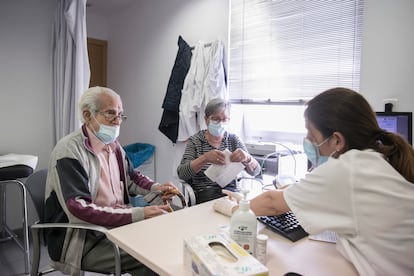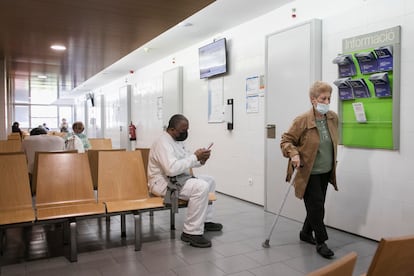Spain’s primary healthcare centers buckling under pressure from pandemic
Health professionals are calling for more resources to cope with the work overload caused by the coronavirus crisis, with an estimated 5,000 more family doctors needed


Walking slowly in flip-flops and socks and holding tightly to his cane, 90-year-old Manuel Fernández crosses the threshold of the nurse’s office at the Besòs primary healthcare clinic in Barcelona. He is going for a Synthrom check – the anticoagulant used to prevent thrombosis – but, while he’s there, he tells the nurse, Jaione Pérez, about his knee and the trouble it’s giving him. “I turned 90 and it seems that everything hurts now,” he grumbles. “I was better before I turned 90.” He has an appointment with the family doctor the next morning, but Pérez manages to squeeze him into today’s schedule to prevent him from having to make another trip. Fernández has gone a year without visiting the center and, although he admits he has made up for his absence in the past month and a half, tears well up in his eyes at the mention of his doctor and nurse. “It would have been best not to have had to come,” he says. “But they are wonderful. Very good. Always.”
The past year has been a hard one for everyone. The coronavirus pandemic brought a surfeit of uncertainty and kept patients away from primary healthcare centers. These centers had to reinvent themselves to deal with the risk of coronavirus contagion while also responding to the needs of their regular patients and the flood of suspected Covid-19 cases. During last year’s spring lockdown, the phone was the main tool for treating those seeking care, although, according to doctors, the doors of primary health centers were never closed.
In fact, the demands on these centers have multiplied over the past year – from detecting coronavirus cases and contact tracking to coordinating care in nursing homes and, in recent months, managing the Covid-19 vaccination campaign. “We healthcare workers are exhausted,” says Cristina Sánchez Quílez, the technical secretary for primary healthcare at the Spanish Confederation of Medical Unions (CESM).
We have never been closed. We are seeing 70 patients a day, 20 of them in personRosa Magallón, Spanish Society for Public Health and Health Administration
There has been no respite for primary healthcare during the pandemic, but now that the worst appears to be over and the vaccination campaign has brought the mortality rate down, health centers are taking stock of the collateral damage. “We have emerged from this much worse than we went in,” says Sánchez Quílez. “The shortfalls in primary healthcare are much greater now because we have seen no additional staff nor resources.”
Rosa Magallón, president of the Spanish Primary Care Network at the Spanish Society for Public Health and Health Administration (Sespas), agrees. “The pandemic has stretched funding for primary healthcare further,” she says. “There is a lack of investment in resources which is agonizing. We are experiencing significant physical and emotional exhaustion.” The CESM estimates that 5,000 more family doctors would need to be incorporated to alleviate the shortfalls in the primary healthcare sector.
Doctors working in primary healthcare centers have been calling for more human resources and investment for years now. Public health spending amounts to €75,000 million, which is 6% of Spain’s gross domestic product (GDP); that is, €1,594 per inhabitant. But only 16% of the total sum is earmarked for primary healthcare. “Our healthcare model is hospital-centric,” says Diego Ayuso, secretary general of the General Council of Nursing Associations (CGE). “There is a tremendous lack of resources. In Europe, primary healthcare accounts for 25% of health spending.”
According to those working within the sector, the pandemic has only exacerbated the situation. “Primary healthcare is the cornerstone [of healthcare] that nobody sees and nobody nurtures,” says Sánchez Quilez. “They close centers, move professionals to provide less reliable care and do not replace those who take vacations or sick leave.”
The professionals in the sector are tired and exhausted, but also frustrated. “We have gone from applause to insults,” says Magallón, in reference to the nightly rounds of applause in honor of essential workers, in particular, health workers, that took place during the spring lockdown. “We are being overlooked. The fact we have never been closed has not been explained properly so the user has a different perception. The plans afoot now to resume face-to-face care are deeply offensive to us because we have never been closed. We are seeing 70 patients a day, 20 of them in person.” The same feeling of being sidelined is echoed by Lorenzo Armenteros, president of the Spanish Society of General Practitioners (SEMG). “The public has been told that it is the primary healthcare doctors who do not want to see patients in person, and that is not true,” he says. “We are willing to do so, but organizational mechanisms must be put in place so they are given the time they need.”
Only 16% of the total health spending is earmarked for primary healthcare, compared to 25% in Europe
Phone consultations have provided a means of dealing with social distancing during the pandemic but it is not a panacea, according to professionals within the sector. They do not resolve all the patients’ queries, nor are they necessarily quicker. “We have a massive workload,” says Ana Arroyo, a doctor in Mérida and vice-president of the Spanish Society of Family and Community Medicine (Semfyc). “The phone consultation is twice as much work because it involves looking at more data, asking more questions and reviewing the patient’s clinical history several times. And in the end, you have to arrange a face-to-face consultation because you haven’t solved the problem.”
Located in one of the most disadvantaged neighborhoods of Barcelona, the Besòs healthcare center is also keen to get back to face-to-face visits and has organized in-person appointments in such a way as to avoid crowds in the waiting rooms. Last autumn, it was difficult for them to cover the quota of face-to-face visits because people were scared of catching the virus, but things have changed. “People have lost their fear of coming and know that the doors are open,” says Roser Masa, a doctor and assistant director of the center.

At the center, Dr Fran Montoya is having a face-to-face consultation with Liria Trujillo, 49, for a catarrhal condition. “I had scheduled her for a phone consultation, but as today was quieter, I told her to come in for an examination,” he says. Gradually, healthcare centers are returning to relative normality and their regular patients are coming back in person, but the pandemic has altered the spectrum of complaints. At first, there was a surge of patients with chronic illnesses, especially diabetes, which has been exacerbated by the sedentary lifestyle imposed by lockdown. “Now the consultations are longer because the patients explain everything that has happened to them during the period they have not come and new ailments have also emerged,” says Montoya. “I have three or four patients with long Covid.” But the consultations that have increased the most concern mental health, according to Masa.
The negative impact on mental health is the pandemic’s most significant legacy; the fear of returning to crowded spaces, agoraphobia, mood disorders. “Last week, I saw four patients who said ‘I look out of the widow a lot,’” says Magallón. “There is immense social isolation, especially among young people, and an exacerbation of overly cautious behavior due to the fear of Covid, particularly in older people, that leads to a lot of loneliness, mental illness and the desire to disappear.”
Workload
Primary healthcare doctors now have misgivings about the future. The pandemic is easing, but the workload remains the same. And there are still staff shortages. “There is inadequate follow-up and seeing patients has been slower,” says Ayuso. “The ratios are inadequate and the nurses can’t cope. They are overwhelmed and have the feeling they are not providing quality care.”
In Spain, powers over healthcare are devolved to the regions, meaning each region has its own system. In Valencia, for example, only 6,000 of the more than 9,000 contracts signed to reinforce the healthcare system during the pandemic will be extended, although those who remain will be channeled into primary healthcare and emergency units. In Madrid, meanwhile, the Central Healthcare Directorate that oversees 49 outpatient clinics, is planning a phased restructuring to deal with both staff shortages and the summer months, during which 41 of these centers will close.
Primary healthcare professionals demand not just to be heard, but also greater staff numbers. They want attractive contracts so that doctors finishing residencies do not go directly to hospital emergency units, where the conditions are more favorable, and nurses do not go abroad, enticed by better pay. “Right now we are all overloaded,” says Armenteros. “There is not a single doctor in Spain who can say the demands for an appointment match what they have scheduled.” There are 43,000 doctors and 39,000 nurses working in Spain’s primary healthcare system. The ratio per inhabitant regarding doctors is one for every 1,342 inhabitants and one for every 980 in the case of pediatricians. With respect to nurses, it is one for every 1,485, according to the Spanish Health Ministry.
Doctors are also demanding more autonomy in how they manage their schedules and faster processes when it comes to communication and referral to specialized care. “Just as we were denied the possibility of carrying out PCR tests during the first wave of the pandemic, we are still being denied management capacity, which would be good for reducing waiting lists,” says Magallón. Primary and specialized care are linked: if one does not run smoothly, the other suffers too. “What we have noticed is that hospitals have done a lot of filtering and have discharged many patients with instructions that they continue to be monitored by the primary healthcare doctor,” says Masa. “There is far less face-to-face consultation and more phone consultation. But the overload also has repercussions on us.”
Arroyo, meanwhile, warns of the risks of weakening the primary healthcare system. “The most vulnerable are left untreated and hospitals are overwhelmed,” she says. “If primary healthcare doesn’t work, the whole health system goes down the drain.”
English version by Heather Galloway.
Tu suscripción se está usando en otro dispositivo
¿Quieres añadir otro usuario a tu suscripción?
Si continúas leyendo en este dispositivo, no se podrá leer en el otro.
FlechaTu suscripción se está usando en otro dispositivo y solo puedes acceder a EL PAÍS desde un dispositivo a la vez.
Si quieres compartir tu cuenta, cambia tu suscripción a la modalidad Premium, así podrás añadir otro usuario. Cada uno accederá con su propia cuenta de email, lo que os permitirá personalizar vuestra experiencia en EL PAÍS.
¿Tienes una suscripción de empresa? Accede aquí para contratar más cuentas.
En el caso de no saber quién está usando tu cuenta, te recomendamos cambiar tu contraseña aquí.
Si decides continuar compartiendo tu cuenta, este mensaje se mostrará en tu dispositivo y en el de la otra persona que está usando tu cuenta de forma indefinida, afectando a tu experiencia de lectura. Puedes consultar aquí los términos y condiciones de la suscripción digital.
More information
Últimas noticias
There is as much life left to discover on planet Earth as that which is already known
Dozens presumed dead, around 100 injured in fire at Swiss Alps bar during New Year’s celebration
Is porn for women different from conventional porn? We spoke to those who make it
Cartagena de Indias is sinking: What can the city do to mitigate it?
Most viewed
- Reinhard Genzel, Nobel laureate in physics: ‘One-minute videos will never give you the truth’
- David King, chemist: ‘There are scientists studying how to cool the planet; nobody should stop these experiments from happening’
- Sinaloa Cartel war is taking its toll on Los Chapitos
- Oona Chaplin: ‘I told James Cameron that I was living in a treehouse and starting a permaculture project with a friend’
- The Interoceanic Train, the Mexican alternative to the Panama Canal










































